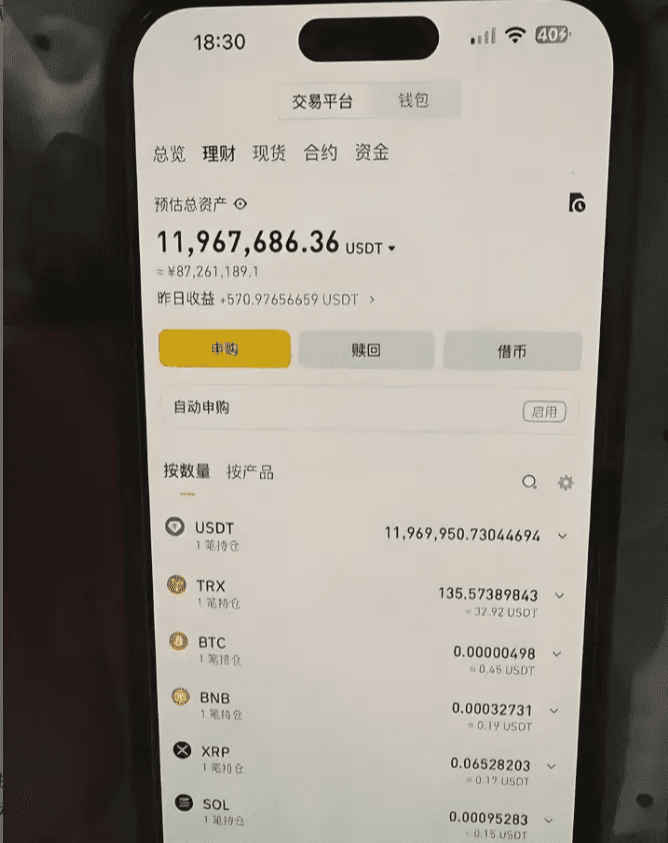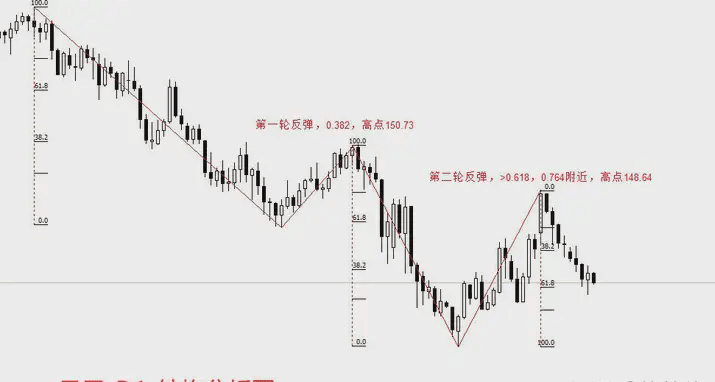From my own experience, trading in the crypto space is the simplest and fastest way to make money! Let me introduce myself: I was born in 1989 and entered the crypto space in 2013, but I really started having fun in 2016. In 2017, I hit a big bull market and made my first 10 million right from the start; after that, I got a bit carried away.
After three liquidations, I lost all the money I made, and I also lost over 3 million of my parents' hard-earned savings. I even borrowed 5 million from relatives and friends to trade, and ended up paying tuition to the market, cumulatively burning through tens of millions in assets.
Under such great pressure, I have thought about jumping off a building several times. Fortunately, my willpower remained strong; I believed I could earn it back! The last time, when the account zeroed out, I actually laughed—during extreme pain, I touched the pulse of the market, and later began to immerse myself, summarizing the mistakes I made earlier, analyzing operational errors, observing the thoughts and techniques of those trading masters. I spent two years turning 200,000 into tens of millions. Each crash is the fire of an alchemy furnace, burning away restlessness and leaving behind real gold.

If your funds are within 50,000 and you're worried about losses, here's a simple yet effective crypto trading method suitable for anyone to operate, helping you maintain 'evergreen' profits! This method has no technical barriers; just follow the steps, and you can earn at least 3%-10% more profit daily in the future!
Method details: batch and staggered trading.
1. Batch fund management.
Assuming you have 10,000 funds, split it into five parts, using only 2,000 for each trade. This way, even if the market fluctuates, you can reserve funds to cope with emergencies. $ETH
2. Test the waters with small investments.
Start by using 2,000 to test a cryptocurrency, checking the market trend to avoid high risks from investing everything at once. $BTC
3. Add to your position after a drop.
If the coin price drops by 10%, use 2,000 to add to your position, lowering your holding cost and waiting for a rebound to profit.
4. Take profits in a timely manner when the price rises.
If the coin price rises by 10%, immediately sell a portion to lock in profits and avoid greed leading to a drawdown.
5. Repeat the cyclical operation.
By following this step, continuously repeating the 'buy-sell-add to position' operation until funds are exhausted or the cryptocurrency is completely sold out, maximizing profits. Advantage analysis:
• Low risk: funds are invested in batches, controlling position risks. #Bitcoin
• High flexibility: adjust operations at any time based on market changes, moving in and out freely. #BTC
• Stable income growth: daily rolling operations, steadily accumulating profits.
9.
Stubborn strategy: refusing to change even when the strategy is wrong, still waiting for a turnaround.
If a strategy has been losing for two weeks and you are still unwilling to change it, saying 'this is a pullback period' while feeling uncertain inside.
You are not believing in the strategy; you are escaping reality.
Advice: strategies need to adapt to the market, not the other way around. Review regularly and adjust flexibly.
10.
Occasional belief type: after making a profit once, you think you've found the holy grail.
You made a profit using a certain strategy and thought you discovered the 'universal method,' but after consecutive failures, you still refuse to admit mistakes.
You hit a wall but refuse to turn back because you think 'that wall is a passage.'
Advice: every strategy has its failure moments. Continuous learning and updating your understanding is the true sustainable competitiveness.
11.
Reflective trading: once you get it wrong, you sink into reviewing and regretting.
Do you often reflect on a 'trade that should have made money'?
You keep thinking that if you had sold a bit slower or bought a bit faster at that time, it would have been better.
Then you fall into the vortex of emotions, unable to extricate yourself.
Advice: trading should be forward-looking. Truly capable individuals take experiences from failures, not emotions.
[Don't let emotions trade you.]
Trading cryptocurrency is never just about technical skills; it’s a battle of cognition, emotions, and self-discipline.
The market always goes 'up and down,' but you cannot follow it 'up and down.'
When you no longer see price fluctuations as an emotional barometer,
When you can persist in your own rhythm amidst the noise,
You have truly embarked on the path to becoming a mature trader.
What you fear most in trading is not market fluctuations, but the confusion within yourself.
Let go of your obsessions, see yourself clearly, and you can survive longer and go further in the crypto space.
Six ironclad rules for ordinary people to achieve financial freedom.
(Every word hits hard but can save lives.)
1. First, break through the 'ceiling of working for others.'
Don't be fooled by the soup that says 'effort will be rewarded.' The truth in the workplace is: effort is not valuable; the ability to solve problems is valuable.
→ Programmers shouldn't blindly follow trends to become streamers; developing a tool software for streamers is more profitable.
→ Fitness trainers should customize nutrition plans + psychological services, increasing income threefold.
Action formula: your skills × market demand = wealth code.
(Can't find direction? Ask yourself: what things would others pay you for help with?)
2. Get rid of the 'human-powered dry battery' model.
Low-level side jobs trade time for money (accepting orders, running errands), while high-level side jobs use systems to make money:
→ Write a book (the cost of selling 100 copies is the same as selling 10,000 copies)
→ Create courses/build communities (one-time production, unlimited harvesting)
→ Develop tools/software (like an AI tool that helps streamers batch edit videos)
Remember: real wealthy people live on 'passive income.' Are you still trading your life for money?
3. Stubbornly pursuing a compound interest type track.
Don't chase the trends; choose fields that become more valuable with age:
→ Personal IP (followers = future ATM; posting 100 videos is 100 times better than posting 10)
→ Knowledge system (dig deep into a field to become an expert; consulting fees in the four-digit range per hour)
→ Passive income (writing books, creating courses, developing digital products)
Three years later, compound interest will reward those who are grinding hard right now.
4. Weld risks into a cage.
The most common mistake ordinary people make: betting their hard-earned money on the myth of getting rich quickly.
→ Don't touch leveraged trading (you can't outplay the big players).
→ Focus on stable tracks that 'trade skills for money' (like helping companies with AI transformation consulting).
Remember: survive first, then talk about making money.
5. Execution trumps all 'perfect plans.'
The essence of financial freedom: validate ideas with action, not kill opportunities with empty thoughts.
→ Live streaming sales? Just go live and sell; don't spend half a year researching personas.
→ Creating media content? Post three pieces of content daily to test the market; failure cost = 0, success returns = ∞.
What you lack is not good ideas, but the determination to start immediately.
Playing in the crypto space is essentially a battle between retail investors and big players. If you don't have super strong professional skills, you can only be cut! Those who want to layout together and harvest from the big players can come (public account: Yuan Yuan Ju Cai), welcome like-minded crypto people to discuss together~
If you want to treat trading cryptocurrency as a second job to support your family, you must seriously study this article to at least save yourself ten years of detours!
ATFX Forex Market: Japan's core inflation rate in April was 3.5%, and expectations for the Bank of Japan to raise interest rates have increased.
ATFX Forex Market: According to data from Japan's Ministry of Internal Affairs and Communications, Japan's core CPI year-on-year in April was 3.5%, higher than the previous value of 3.2% and the expected value of 3.4%, marking a new high since February 2023; Japan's national CPI year-on-year in April was 3.6%, unchanged from the previous value and higher than the expected value of 3.5%; Japan's national CPI month-on-month in April was 0.4%, higher than the previous value of 0.3%. Among the three key data points, two were higher than the previous values, indicating that Japan's price levels are steadily increasing.
At the beginning of this month, Bank of Japan Governor Kazuo Ueda stated that they will closely monitor price trends, as global economic uncertainties remain high. If the economy meets expectations, the Bank of Japan will continue to adjust the intensity of monetary easing. This statement indicates that the Bank of Japan prioritizes the performance of core CPI year-on-year data in adjusting monetary policy. In April, Japan's core CPI year-on-year surged from 3.2% to 3.5%, showing preliminary signs of possible hyperinflation, which may force the Bank of Japan to raise interest rates again.

▲ATFX chart
By overlapping the curve of Japan's core CPI year-on-year with the Bank of Japan's interest rate curve, it is evident that Japan's inflation rate began to rise steadily in January 2021 and is expected to break through the moderate inflation ceiling of 3% by December 2024. During the same period, the Bank of Japan's interest rates have also been steadily increasing from negative values. Since February 2024, the Bank of Japan has raised rates three times, with a cumulative increase of 60 basis points, the latest value being 0.5%. The next interest rate decision by the Bank of Japan is on June 17; although there was no change in March and May, the probability of a rate hike in June is continuously increasing.
Uncertainty comes from the international market. The results of negotiations between the U.S. and Japan have not yet been disclosed, making it difficult to accurately assess the impact of Japan's import-driven inflation. If Japan makes significant concessions in negotiations, such as importing more American goods that 'do not have price advantages,' Japan's inflation rate may continue to soar. This is why, in the face of high inflation data, mainstream expectations still believe the Bank of Japan will remain inactive in June.

▲ATFX chart
From the perspective of market structure, on the daily level, the yen is in a medium to long-term bearish trend, with the latest wave being a decline. The market price is running near the 0.618 Fibonacci retracement level, recently focusing on the support role of this level. Yesterday's candlestick was quite special, with long upper and lower shadows and a small body, indicating signs of bottoming. Coupled with the market price being at the Fibonacci level, the probability of a short-term rebound is relatively high. If the bearish trend continues, attention needs to be paid to the previous low of 139.87, followed by the extended Fibonacci levels of 1.382 at 136.54 and 1.618 at 139.49, where the market is most likely to see a turning point.
You must pay attention to these eight iron laws, all practical tips for making money in crypto trading; it's recommended to save them!
1. Spot-based dollar-cost averaging should be the bulk, occupying at least 70% of the position. The remaining 30% can be used for new investments or for those higher-risk ones.
Large projects with high winning odds!
2. There are many projects in the crypto space; for projects that require capital, most of the time, it's better to observe more and act less. If you really want to participate, you need to be cautious.
Once the evidence is in hand, it's a success.
3. Dollar-cost averaging in the secondary market, during the transition from a bear market to a bull market, just buy without selling; if it drops, buy; if it drops sharply, buy more. From bull market to...
During a bear market, just sell and don't buy. Sell when it rises, a little at a time.
4. Don't play with contract leverage, and don't touch those risky projects in the domestic market.
5. Let me tell you about the fish-eating theory. From the various groups you joined, you can gauge what stage your invested project is at. If everyone in the group is shouting...
If eight out of ten groups are shouting to buy, this project might just be at a temporary peak. Consider selling a portion.
6. If you encounter short-term projects that rise significantly, when selling, first recover the costs and some profits, leaving the remaining profits in the project.
This way, you will feel more at ease.
7. The timing for buying can also be judged from the groups. If you find that everyone in the group is cursing this project and there are complaints online, then this project...
The target is probably at a temporary bottom.
8. Whether it's a short-term popular project or a long-term story-driven one, what you participate in must be the leader in this niche field or protocol.
The second-tier projects are often more recognized, have more stories to tell, and are easier to hype!
When the market starts, profits double! Follow Cheng Ge and do what the market does; wealth will naturally come.
Keep an eye on: SPK, C.




